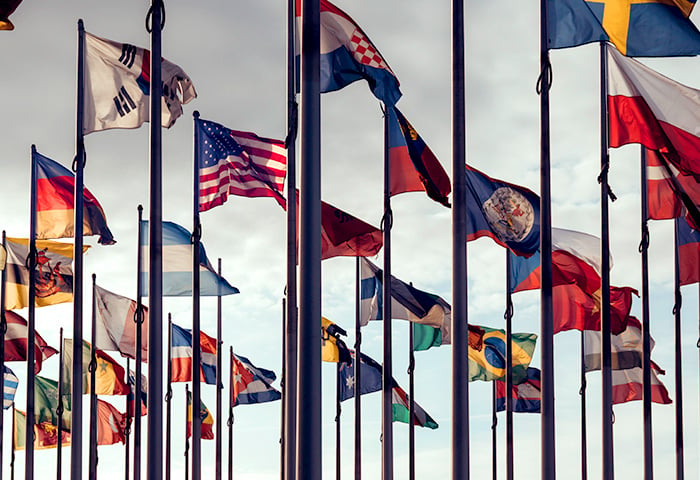How can I unblock YouTube?
The best way to unblock YouTube is to use a VPN, which allows you to select your VPN server location and encrypts your connection to bypass geo-blocking and network restrictions. If using a VPN isn’t an option, proxy servers and a wide range of other alternatives can also help — offering several choices for those who want to access their favorite content on the road.
The 11 methods to unblock YouTube covered in this guide can also be used to unblock other websites. Keep in mind that some methods may require specific browsers, so make sure to check which browser you’re using to guarantee compatibility with your chosen unblocking technique. Now, let’s dive in:
1. With a proxy server
A proxy server acts as an intermediary between you and YouTube, allowing you to access content as if you're browsing from a different location. When you use proxy servers, YouTube sees the IP address of the proxy instead of yours, helping you bypass location-based video restrictions and unblock content.
They have the advantage of not requiring a software install, but network administrators may block access to public proxy sites, and since your internet traffic isn’t encrypted, they’ll still be able to monitor — and block — your YouTube access using a firewall.
And although popular webpage proxies and websites that unblock YouTube such as YouTube Unblocked, Infinite, and Unblock YouTube, are generally considered safe, they can still expose your internet activity to surveillance and hacking risks. Some free web browser proxies may even be designed to steal your information or infect your device with malware.
Even the best unblocked YouTube sites and sophisticated DNS proxies fall short compared to safer and more reliable alternatives, such as VPNs, which are just as easy as setting up a proxy server and offer additional benefits.
2. With proxy browser add-ons
You can also access proxy servers via a proxy browser extension. If network restrictions are blocking the URLs of popular proxy server sites, an unblocked proxy extension may allow you to freely view videos usually only available in other countries.
Aside from this key difference, proxy browser add-ons share most of the same strengths, weaknesses, and risks as a regular proxy server. The unencrypted connection exposes your web traffic and won’t be able to bypass certain types of blocking. As this answer from Quora shows, you’ll also need to change some advanced browser settings, making proxy add-ons a little complicated to set up.
If you’ve been using one of these add-ons, or any other extension, and are worried about your internet security, make sure to learn how to remove Chrome extensions.
3. SOCKS5 proxies
A SOCKS5 proxy differs from a regular proxy service in that it can handle internet traffic from any app, not just a web browser, making it useful for torrenting, gaming, or accessing blocked content via the YouTube app. However, SOCKS5 proxies still lack encryption, leaving your data exposed to the same security risks as free web proxies used to unblock YouTube.
In more technical terms, SOCKS5 proxies support multiple protocols beyond HTTP and HTTPS, including TCP/IP, UDP, SMTP, and FTP, making them more versatile than standard proxies. While HTTP proxies are faster for web traffic, SOCKS5 excels in handling diverse network connections, making it a better choice for users who need flexibility across various applications.
4. VPN
A VPN is the most versatile, reliable, and secure method for unblocking YouTube. It not only allows you to change your IP address but also encrypts your internet traffic, helping you bypass a wide range of content restrictions, including geo-blocking, network or ISP-based blocking, DNS filtering, and even deep packet inspection, all while helping to keep your online activity private.
Setting up a VPN is simple: just pick a VPN server location, click “connect,” and YouTube will see only the VPN’s IP address. But the freedom to customize your virtual location is just one of the reasons why you should use a VPN — these powerful privacy and security tools anonymize your online activity, shield the data you send and receive from hackers, and provide extra security when you’re completing sensitive activities like online banking.
Better yet? Full-function VPN apps are also available for iOS, Android, and other platforms. Setting up a VPN on iPhone and Android is quick and easy, meaning you can enjoy broader content access and peace of mind with a mobile VPN, even when browsing on public Wi-Fi.

Try AVG Secure VPN for free today and start enjoying your favorite content right away with a wide selection of geo-optimized server locations, ultra-fast speeds, and unlimited bandwidth.
5. Using Tor browser
Tor browser enhances anonymity by routing your data through several layers of encryption via intermediary nodes, making it nearly impossible to trace your activity. While it's mainly used for anonymous browsing on the dark web, it can also help mask your IP address to access blocked content, such as YouTube videos.
However, the dark web is notoriously dangerous, and even navigating the best dark websites can be risky. Tor also lacks end-to-end encryption, with your IP address visible to the first network node, and the last node accessing unencrypted data, potentially exposing your identity and sensitive information.
Tor’s complex network can also lead to slow speeds, and the inability to select a virtual location to access specific content makes it less than ideal for bypassing YouTube blocks. Unlike Tor or proxy servers, a VPN offers a balance between strong privacy, fast speeds, and customizable connection options, making it a better choice for unblocking content securely and efficiently.
6. Using SafeShare
SafeShare is a site that streams YouTube videos without anything else on the screen. Designed to help teachers show videos without displaying anything inappropriate or distracting, it can also serve as a simple workaround for blocked YouTube content. However, be aware that some networks may have blocked SafeShare as well, so it’s not always a guaranteed solution.
7. Google Translate
Believe it or not, Google Translate can act as a simple proxy to access blocked YouTube content. By entering a YouTube URL and translating the page from one language to another, Google serves the page through its own servers, helping to bypass some network restrictions.
Here’s how to re-tool Translate as a YouTube unblocker:
-
Combine the Google Translate URL and the URL of the YouTube video you want to watch into a single URL by putting the YouTube URL at the end of the Google Translate URL.
-
Enter the combined URL into your browser address bar, hit enter, and start streaming.
It’s a neat hack but also relatively well known as a method to unblock YouTube videos on a school computer. That means some institutions will already be wise to this method and have Google Translate blocked, too.
8. With a mobile hotspot
Using a mobile hotspot can bypass YouTube restrictions set by your school or organization since it relies on your phone’s data connection instead of the restricted network. However, if you’re trying to use a work phone to unblock the YouTube app, your organization may have set it up to block certain sites, even over mobile data.
Creating a mobile hotspot on iPhone
-
In the Settings app, tap Mobile Service, ensure Mobile Data is toggled on, and then tap Personal Hotspot.

-
Toggle Allow Others to Join on, take note of the Wi-Fi password, and then connect to the network on your other device.

Enabling a Wi-Fi hotspot on Android
-
Open Android Settings and tap Connections.

-
Tap Mobile Hotspot and Tethering and toggle Mobile Hotspot on.

Keep in mind that using a mobile hotspot can drain your battery. You may want to boost your Android’s battery life to make the most of this feature, especially if your battery is already draining fast. Also remember that using your mobile hotspot will consume mobile data, so ensure that your plan is sufficient to cover your needs before considering this option.
Your phone’s hotspot isn’t totally secure either, so whenever you’re using mobile data be sure to help keep yourself protected by following these seven essential iPhone security tips.
9. Using the bookmarking method
The JavaScript bookmarking method (or bookmarklet) works by saving a small JavaScript code snippet as a bookmark in your browser. When activated, it modifies page elements that can help unblock YouTube on your Chromebook or other restricted devices.
Here’s how to use bookmarking to unblock YouTube on Chrome:
-
In Chrome, type Ctrl + Shift + B to show the Bookmarks toolbar if it isn’t already on your screen, then right-click it and select Add Page.

-
Choose a name for the bookmark and copy and paste the following text into the URL field:
javascript:(function () {if (window.location.toString().includes('www.youtube.com/watch?v'))%20{%20window.open('https://www.youtube-nocookie.com/embed/'%20+%20window.location.toString().split('=')[1])%20}})()

-
Find the YouTube video you want to watch on Google and click to open it.

-
From the blocked content page, click the unblocker bookmark you created to run the script and the video should load.
10. By removing restricted websites from the admin menu
This method requires admin access, so it won’t work on a school or work computer. It also won’t help if the video you’re trying to watch is limited by geo-blocking or network restrictions. However, it may be effective if you’re the device administrator and think your internet security settings may be blocking you from YouTube.
Here’s how to unblock YouTube if it’s blocked by an administrator:
-
Type “internet options” into the taskbar and hit the Enter key.

-
Click on the Security tab of the Internet Properties pop-up window.

-
Scroll to the right and click Restricted Sites, and then the button below that says Sites.

-
Highlight “youtube.com” or any other listed site you want to unblock and click Remove.

11. Modifying the URL
If the network you’re on relies on a very basic blocking system that filters specific URLs, you might bypass it by switching between HTTP and HTTPS. So, if “https://www.youtube.com” is blocked, trying “https://www.youtube.com” could work.
However, HTTP is an unsecured protocol, making any data you transmit on an HTTP website vulnerable to interception. We don’t recommend this method, and you should never enter personal information or passwords on HTTP sites.
Why is YouTube blocked in the first place?
The entire YouTube site and app, or specific videos on the platform, may be blocked for several reasons, such as network restrictions designed to limit distractions in schools or workplaces, geo-blocking due to licensing agreements, government censorship in certain countries, or YouTube policy restrictions for legal, safety, or copyright reasons.
Here’s a closer look at some of the main reasons why YouTube may be blocked for you:
Broadcasting right restrictions
Broadcasting rights restrictions cause YouTube videos to be blocked in certain regions due to licensing agreements. Media companies, sports leagues, and streaming platforms enforce these limits to protect exclusive deals. YouTube determines your location via your IP address, so users outside authorized areas may see messages like “This video is unavailable in your country.”
Institutional network blocks
Schools typically block YouTube to protect children from inappropriate content, while some companies do the same to minimize distractions and boost productivity. These restrictions are enforced through firewalls, which analyze and filter internet traffic and block access to specific websites.
Government censorship
YouTube is banned in countries like China and Iran due to strict internet censorship, often alongside other social media and streaming platforms. While certain methods can bypass these restrictions, doing so may be illegal in some regions, where even VPN usage is restricted and could lead to legal consequences.
Age restrictions
Age restrictions on YouTube prevent underage users from accessing content deemed inappropriate due to violence, explicit language, or other mature themes. Videos flagged as age-restricted require users to sign in and verify their age. YouTube also offers a Restricted Mode, which is a filtering feature that hides potentially mature or inappropriate content. If enabled by an admin, you won’t be able to turn it off without their permission.
Creator restrictions
Creator restrictions on YouTube let accounts limit access to the content they share based on factors like age, location, or content type. These limitations are often imposed by content creators to comply with local laws, advertising policies, or community guidelines.
How safe are free YouTube unblockers?
While free YouTube unblockers may provide quick access to blocked videos, they come with significant risks, such as exposure to malware, data breaches, and potential hacker exploitation. For your safety, don’t use these free tools, which may not work against sophisticated content blockers anyway.
Likewise, if you’re downloading videos or music from YouTube, ensure you use a trustworthy, virus-free YouTube downloader. And be mindful that YouTube blocks are often in place for good reasons, so consider your child’s online safety before allowing access to these methods.
Using a safe VPN from a reputable provider is a much more effective and secure option. It’s easy to set up, works seamlessly on Macs, PCs, and mobile devices, and will boost your privacy and security instead of compromising it.
Access content securely with a VPN
A VPN is the ultimate tool for changing your IP location and hiding your network activity, helping you access your favorite content, and ensuring your browsing activity is protected from hackers, ISPs, and other snoops.
With AVG Secure VPN, you can select from multiple virtual locations to stream and view content securely. It uses bank-grade 256-bit AES encryption, keeping your online traffic safe while helping you access your favorite content on the go. Start your free trial today for secure streaming and browsing.



























